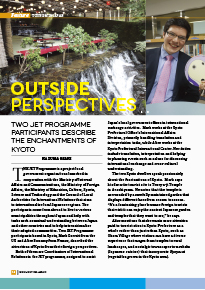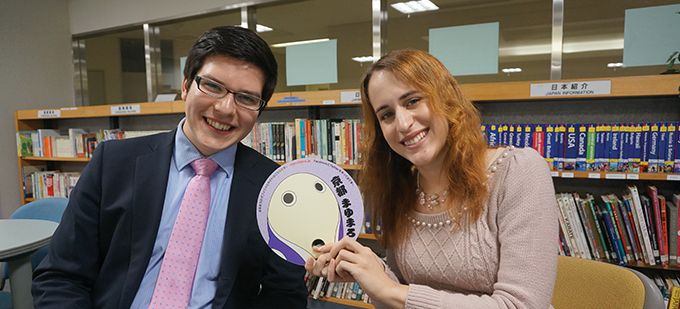Home > Highlighting JAPAN >Highlighting Japan April 2015>Tourism in Japan
Highlighting JAPAN

Tourism in Japan
Outside Perspectives
Two JET Programme participants describe
the enchantments of Kyoto

The JET Programme is a project local government organizations launched in cooperation with the Ministry of Internal Affairs and Communications, the Ministry of Foreign Affairs, the Ministry of Education, Culture, Sports, Science and Technology and the Council of Local Authorities for International Relations that aims to internationalize local Japanese regions. The participants come from abroad to live in various municipalities throughout Japan and help with tasks such as mutual understanding between Japan and other countries and to help internationalize their adopted communities. Two JET Programme participants based in Kyoto, Mark Garratt from the UK and Alice Bonamy from France, described the attractions of Kyoto from their foreign perspectives.
Both of them are Coordinators of International Relations in the JET programme, assigned to assist Japan’s local government offices in international exchange activities. Mark works at the Kyoto Prefectural Office’s International Affairs Division, primarily handling translation and interpretation tasks, while Alice works at the Kyoto Prefectural International Center. Her duties include translation, interpretation and helping to planning events such as salons for discussing international exchange and cross-cultural understanding.
The two Kyoto dwellers speak passionately about the fascinations of Kyoto. Mark says his favorite tourist site is Tenryu-ji Temple in Arashiyama. He notes that the temple is surrounded by a carefully maintained garden that displays different faces from season to season. “It’s a fascinating place because foreign tourists that visit it can enjoy the ancient Japanese garden and temples that they want to see,” he says.
Alice mentions that she wants more attention paid to tourist sites in Kyoto Prefecture as a whole rather than just urban Kyoto, such as Ohara Village where visitors can have a diverse experience that ranges from temples to rural landscapes, and nostalgic townscapes to washoku (Japanese cuisine) that incorporate Kyoyasai (vegetables grown in the Kyoto area).
“Even aside from Ohara, if you go to tourist sites such as Kurama and Kibune, you can enjoy kawadoko-ryori [restaurants set up above the river in summer] while experiencing the atmosphere of being surrounded by abundant nature,” she says. “There are also the thatched roof houses of Kayabuki no Sato in Miyama town, where you can experience something unique.”
Through their lives in Kyoto, the two say they have come to understand the city better. “My original image of Kyoto was void of any skyscrapers,” Mark says. “Instead I pictured the townscape of Gion that I often saw in anime and movies.” He was shocked by the modern spectacle surrounding Kyoto Station. By getting to know small stores that sandwich narrow streets such as Nishiki market, however, he explains that he has finally seen Kyoto as it is in people’s daily lives. As food ingredients and dishes are bought and sold, one can feel the essence and charm of Kyoto by looking at this bustling scene from the ordinary lives of local residents.
Alice relates that she first came to Kyoto while traveling in Japan during college. “However, I was mostly interested in pop culture at the time, and after the hustle of Tokyo, I thought Kyoto only had a lot of temples and maiko (apprentice geisha), so I found it somewhat boring,” she says. After she started living in Kyoto, though, she realized she had only glimpsed the city’s surface. Seeing people wearing kimonos on a daily basis and streets tucked between traditional old buildings with small crafts shops hidden away, she was touched by the wide range of Kyoto’s culture. “The more time you spend in Kyoto, the more the city opens up to you,” she notes.
The two say the best way to enjoy Kyoto is to walk around the city without a guide and fully immerse yourself in the townscape and the lives of the local people. “In particular, if you go to supermarkets and see Kyoyasai, you can examine the way the people of Kyoto really live, and it is absorbing,” Mark explains.
Perhaps for Alice and Mark, the fascination of Kyoto is the chance to experience Japanese culture and tradition more deeply than anywhere else. At the same time, many aspects of Japanese culture are hard to precisely convey to non-Japanese because the culture is so singular and so thoroughly deeply rooted in society. The two will continue to promote this city so that more foreigners can enjoy Kyoto in a wider context.
© 2009 Cabinet Office, Government of Japan






